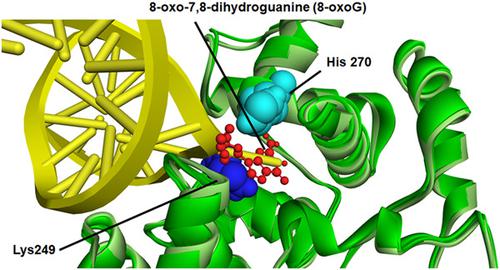当前位置:
X-MOL 学术
›
J. Cell. Biochem.
›
论文详情
Our official English website, www.x-mol.net, welcomes your
feedback! (Note: you will need to create a separate account there.)
4-Hydroxy-2-nonenal attenuates 8-oxoguanine DNA glycosylase 1 activity.
Journal of Cellular Biochemistry ( IF 3.0 ) Pub Date : 2020-07-06 , DOI: 10.1002/jcb.29814 Guodong Pan 1 , Mandar Deshpande 1 , Haiyan Pang 1 , Paul M Stemmer 2 , Nicholas J Carruthers 2 , Colin T Shearn 3 , Donald S Backos 4 , Suresh S Palaniyandi 1, 5
Journal of Cellular Biochemistry ( IF 3.0 ) Pub Date : 2020-07-06 , DOI: 10.1002/jcb.29814 Guodong Pan 1 , Mandar Deshpande 1 , Haiyan Pang 1 , Paul M Stemmer 2 , Nicholas J Carruthers 2 , Colin T Shearn 3 , Donald S Backos 4 , Suresh S Palaniyandi 1, 5
Affiliation

|
Elevated cellular oxidative stress and oxidative DNA damage are key contributors to impaired cardiac function in diabetes. During chronic inflammation, reactive oxygen species (ROS)‐induced lipid peroxidation results in the formation of reactive aldehydes, foremost of which is 4‐hydroxy‐2‐nonenal (4HNE). 4HNE forms covalent adducts with proteins, negatively impacting cellular protein function. During conditions of elevated oxidative stress, oxidative DNA damage such as modification by 8‐hydroxydeoxyguanosine (8OHdG) is repaired by 8‐oxoguanine glycosylase‐1 (OGG‐1). Based on these facts, we hypothesized that 4HNE forms adducts with OGG‐1 inhibiting its activity, and thus, increases the levels of 8OHG in diabetic heart tissues. To test our hypothesis, we evaluated OGG‐1 activity, 8OHG and 4HNE in the hearts of leptin receptor deficient db/db mice, a type‐2 diabetic model. We also treated the recombinant OGG‐1 with 4HNE to measure direct adduction. We found decreased OGG‐1 activity (P > .05), increased 8OHG (P > .05) and increased 4HNE adducts (P > .05) along with low aldehyde dehydrogenase‐2 activity (P > .05). The increased colocalization of OGG‐1 and 4HNE in cardiomyocytes suggest 4HNE adduction on OGG‐1. Furthermore, colocalization of 8OHG and OGG‐1 with mitochondrial markers TOM 20 and aconitase, respectively, indicated significant levels of oxidatively‐induced mtDNA damage and implicated a role for mitochondrial OGG‐1 function. In vitro exposure of recombinant OGG‐1 (rOGG‐1) with increasing concentrations of 4HNE resulted in a concentration‐dependent decrease in OGG‐1 activity. Mass spectral analysis of trypsin digests of 4HNE‐treated rOGG‐1 identified 4HNE adducts on C28, C75, C163, H179, H237, C241, K249, H270, and H282. In silico molecular modeling of 4HNE‐K249 OGG‐1 and 4HNE‐H270 OGG‐1 mechanistically supported 4HNE‐mediated enzymatic inhibition of OGG‐1. In conclusion, these data support the hypothesis that inhibition of OGG‐1 by direct modification by 4HNE contributes to decreased OGG‐1 activity and increased 8OHG‐modified DNA that are present in the diabetic heart.
中文翻译:

4-Hydroxy-2-nonenal 减弱 8-氧鸟嘌呤 DNA 糖基化酶 1 的活性。
升高的细胞氧化应激和氧化性 DNA 损伤是糖尿病患者心脏功能受损的关键因素。在慢性炎症期间,活性氧 (ROS) 诱导的脂质过氧化导致活性醛的形成,其中最主要的是 4-羟基-2-壬烯醛 (4HNE)。4HNE 与蛋白质形成共价加合物,对细胞蛋白质功能产生负面影响。在氧化应激升高的情况下,8-羟基脱氧鸟苷 (8OHdG) 修饰等氧化性 DNA 损伤由 8-氧鸟嘌呤糖基化酶-1 (OGG-1) 修复。基于这些事实,我们假设 4HNE 与 OGG-1 形成加合物抑制其活性,从而增加糖尿病心脏组织中 8OHG 的水平。为了验证我们的假设,我们评估了瘦素受体缺陷患者心脏中的 OGG-1 活性、8OHG 和 4HNEdb / db小鼠,一种 2 型糖尿病模型。我们还用 4HNE 处理重组 OGG-1 以测量直接加合。我们发现 OGG-1 活性降低 ( P > .05)、8OHG 增加 ( P > .05) 和 4HNE 加合物增加 ( P > .05) 以及醛脱氢酶-2 活性低 ( P > .05)。心肌细胞中 OGG-1 和 4HNE 的共定位增加表明 OGG-1 上的 4HNE 内收。此外,8OHG 和 OGG-1 分别与线粒体标记物 TOM 20 和乌头酸酶共定位表明氧化诱导的 mtDNA 损伤水平显着,并暗示了线粒体 OGG-1 功能的作用。随着 4HNE 浓度的增加,重组 OGG-1 (rOGG-1) 的体外暴露导致 OGG-1 活性的浓度依赖性降低。4HNE 处理的 rOGG-1 胰蛋白酶消化物的质谱分析鉴定了 C28、C75、C163、H179、H237、C241、K249、H270 和 H282 上的 4HNE 加合物。4HNE-K249 OGG-1 和 4HNE-H270 OGG-1 的计算机分子建模支持 4HNE 介导的 OGG-1 酶促抑制。综上所述,
更新日期:2020-07-06
中文翻译:

4-Hydroxy-2-nonenal 减弱 8-氧鸟嘌呤 DNA 糖基化酶 1 的活性。
升高的细胞氧化应激和氧化性 DNA 损伤是糖尿病患者心脏功能受损的关键因素。在慢性炎症期间,活性氧 (ROS) 诱导的脂质过氧化导致活性醛的形成,其中最主要的是 4-羟基-2-壬烯醛 (4HNE)。4HNE 与蛋白质形成共价加合物,对细胞蛋白质功能产生负面影响。在氧化应激升高的情况下,8-羟基脱氧鸟苷 (8OHdG) 修饰等氧化性 DNA 损伤由 8-氧鸟嘌呤糖基化酶-1 (OGG-1) 修复。基于这些事实,我们假设 4HNE 与 OGG-1 形成加合物抑制其活性,从而增加糖尿病心脏组织中 8OHG 的水平。为了验证我们的假设,我们评估了瘦素受体缺陷患者心脏中的 OGG-1 活性、8OHG 和 4HNEdb / db小鼠,一种 2 型糖尿病模型。我们还用 4HNE 处理重组 OGG-1 以测量直接加合。我们发现 OGG-1 活性降低 ( P > .05)、8OHG 增加 ( P > .05) 和 4HNE 加合物增加 ( P > .05) 以及醛脱氢酶-2 活性低 ( P > .05)。心肌细胞中 OGG-1 和 4HNE 的共定位增加表明 OGG-1 上的 4HNE 内收。此外,8OHG 和 OGG-1 分别与线粒体标记物 TOM 20 和乌头酸酶共定位表明氧化诱导的 mtDNA 损伤水平显着,并暗示了线粒体 OGG-1 功能的作用。随着 4HNE 浓度的增加,重组 OGG-1 (rOGG-1) 的体外暴露导致 OGG-1 活性的浓度依赖性降低。4HNE 处理的 rOGG-1 胰蛋白酶消化物的质谱分析鉴定了 C28、C75、C163、H179、H237、C241、K249、H270 和 H282 上的 4HNE 加合物。4HNE-K249 OGG-1 和 4HNE-H270 OGG-1 的计算机分子建模支持 4HNE 介导的 OGG-1 酶促抑制。综上所述,











































 京公网安备 11010802027423号
京公网安备 11010802027423号